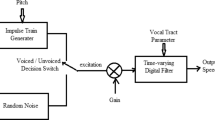Abstract
Speech synthesis can be classified into waveform coding, source coding, or hybrid coding by the synthesis method. Among these, waveform coding is especially suitable for high-quality speech synthesis. However, synthesis techniques using syllable or phoneme unit is not desirable since it fails to separate the excitation and the formant part to handle speech. Therefore, there is a need for a pitch alteration method to apply in synthesis using waveform coding. This study proposes a pitch alteration method that uses spectrum scaling after flattening the spectra by a sub-band linear approximation to minimize the spectrum distortion. A comparison with LPC (Linear Predictive Coding), Cepstrum and lifter function is presented to show the better performance of the proposed method. Estimation method seeks each of the distributions of the flattened signal and measures the degree of the flattened spectrum Signal, which is normalized, so the highest point amounts to zero, and the distribution of the signal, whose average is zero, is calculated. The results are presented by the spectrum distortion rate to estimate the performance of the proposed method. The average spectrum distortion rate kept below the average 2.12%, showing the proposed method’s superiority in comparison with the other existing approaches.
Similar content being viewed by others
References
Bae M.J. (1996) On a pitch alteration method using scaling the harmonics compensated with the phase for speech synthesis. The Journal of the Acoustical Society of Korea 15: 99–103
Bae M.J., Yoon H., Ann S. (1991) On altering the pitch of speech signals in waveform coding alteration method by the LPC and pitch halving. The Journal of the Acoustical Society of Korea 10: 11–19
Caspers B.E., Atal B.S. (1983) Changing pitch and duration in LPC synthesized speech using multi-pulse excitation. The Journal of the Acoustical Society of America 73(1): 55
Jung, C. J., Ham, M. K., & Bae, M. J. (1999). On a pitch alteration technique of speech using the asymmetric weighted window. In MILCOM, Military Communications Conference Proceedings(Vol. 2, pp. 1439–1443).
Kim, J. K., & Bae, M. J. (2001). A study of pitch extraction method by using harmonics peak-fitting in speech spectrum. In ASK, Proceedings of ICSP 2001 (Vol. 1, pp. 617–622).
Kim Y.G., Bae M.J. (2003) A study on the pitch alteration technique by sub-band scaling in speech signal. KASS 10(4): 137–147
Kondoz, A. M., (1994). Digital speech coding for low bit rate communications systems. John Wiley & Sons.
Min, S. Y., Jang, K. A., & Bae, M. J. (2002). The pitch extraction method through spectrum flattening. In Signal, Speech and Image Processing 2002 (ICOSSIP), Proceedings of the WSEAS International Conference (Vol. 10, No. 4, pp. 3151–3154).
Papamichalis, P. E. (1987). Practical approaches to speech coding. Prentice-Hall.
Stearns S.D., David R.A. (1988) Signal processing algorithms. Englewood Cliffs, New-Jersey, Prentice-Hall Inc
Author information
Authors and Affiliations
Corresponding author
Rights and permissions
About this article
Cite this article
Kim, J., Hahn, H., Yoon, UJ. et al. On a Pitch Alteration for Speech Synthesis Systems. Wireless Pers Commun 50, 435–446 (2009). https://doi.org/10.1007/s11277-008-9615-x
Received:
Accepted:
Published:
Issue Date:
DOI: https://doi.org/10.1007/s11277-008-9615-x




